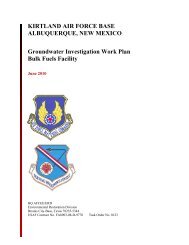Final FONSI and EA for hot cargo pad on Kirtland AFB - Kirtland Air ...
Final FONSI and EA for hot cargo pad on Kirtland AFB - Kirtland Air ...
Final FONSI and EA for hot cargo pad on Kirtland AFB - Kirtland Air ...
Create successful ePaper yourself
Turn your PDF publications into a flip-book with our unique Google optimized e-Paper software.
<str<strong>on</strong>g>Final</str<strong>on</strong>g> <str<strong>on</strong>g>EA</str<strong>on</strong>g> Addressing C<strong>on</strong>structi<strong>on</strong>, Operati<strong>on</strong>, <str<strong>on</strong>g>and</str<strong>on</strong>g> Maintenance of a Hot Cargo Pad<br />
The proposed <str<strong>on</strong>g>hot</str<strong>on</strong>g> <str<strong>on</strong>g>cargo</str<strong>on</strong>g> <str<strong>on</strong>g>pad</str<strong>on</strong>g> would be within the day-night average sound level (DNL) 65 to 69 A-<br />
weighted decibel (dBA) noise z<strong>on</strong>e, <str<strong>on</strong>g>and</str<strong>on</strong>g> proposed taxiway would be within the DNL 70 to 74 dBA noise<br />
z<strong>on</strong>e from aircraft operati<strong>on</strong>s at the Albuquerque Internati<strong>on</strong>al Sunport (see Figure 3-2).<br />
The Proposed Acti<strong>on</strong> would also be within the 1,250-foot-radius QD arc of the existing <str<strong>on</strong>g>hot</str<strong>on</strong>g> <str<strong>on</strong>g>cargo</str<strong>on</strong>g> <str<strong>on</strong>g>pad</str<strong>on</strong>g><br />
(Pad 5). As discussed in Secti<strong>on</strong> 2.1.2, QD arcs are an area surrounding a potential explosi<strong>on</strong> site that is<br />
defined by explosive limits of the potential explosi<strong>on</strong> site.<br />
The northern porti<strong>on</strong> of the proposed taxiway would be within the Runway 26 Clear Z<strong>on</strong>e <str<strong>on</strong>g>and</str<strong>on</strong>g> APZ I at<br />
the Albuquerque Internati<strong>on</strong>al Sunport (K<strong>AFB</strong> 2002). Existing USAF facilities <str<strong>on</strong>g>and</str<strong>on</strong>g> l<str<strong>on</strong>g>and</str<strong>on</strong>g> uses may<br />
c<strong>on</strong>tinue in the Clear Z<strong>on</strong>e; however, replacement facilities should be sited outside the Clear Z<strong>on</strong>e.<br />
Generally, people intensive uses <str<strong>on</strong>g>and</str<strong>on</strong>g> uses not required <str<strong>on</strong>g>for</str<strong>on</strong>g> flight operati<strong>on</strong>s should not be sited within the<br />
Clear Z<strong>on</strong>e. Acceptable l<str<strong>on</strong>g>and</str<strong>on</strong>g> uses within the Clear Z<strong>on</strong>e are: agriculture; livestock grazing (excluding<br />
feed <str<strong>on</strong>g>and</str<strong>on</strong>g> dairy lots); permanent open space; existing or new water areas provided they do not create bird<br />
strike hazards; rights-of-way <str<strong>on</strong>g>for</str<strong>on</strong>g> single track railroads <str<strong>on</strong>g>and</str<strong>on</strong>g> fenced, two-lane highways without sidewalks<br />
or bicycle trails provided they do not violate obstacle clearance criteria; rights-of-way <str<strong>on</strong>g>for</str<strong>on</strong>g><br />
communicati<strong>on</strong>s <str<strong>on</strong>g>and</str<strong>on</strong>g> utilities provided all facilities are at grade level or underground; <str<strong>on</strong>g>and</str<strong>on</strong>g> essential<br />
navigati<strong>on</strong> aids <str<strong>on</strong>g>and</str<strong>on</strong>g> operati<strong>on</strong>al facilities, provided there are no feasible alternatives. In additi<strong>on</strong>, acti<strong>on</strong>s<br />
or uses that create a substance (e.g., dust) that would impair visibility, produce light that would distract<br />
pilots, produce electrical interference, or attract birds are prohibited in the Clear Z<strong>on</strong>e. L<str<strong>on</strong>g>and</str<strong>on</strong>g> use<br />
guidelines within the APZ I are less restrictive; however, uses that c<strong>on</strong>centrate people in small areas are<br />
not acceptable. Some general l<str<strong>on</strong>g>and</str<strong>on</strong>g> uses permitted in the APZ I are industrial/manufacturing,<br />
transportati<strong>on</strong>, communicati<strong>on</strong>/utilities, wholesale trade, open space, recreati<strong>on</strong>, <str<strong>on</strong>g>and</str<strong>on</strong>g> agriculture (USAF<br />
1999).<br />
3.2 Noise<br />
3.2.1 Definiti<strong>on</strong> of the Resource<br />
Sound is defined as a particular auditory effect produced by a given source, <str<strong>on</strong>g>for</str<strong>on</strong>g> example the sound of rain<br />
<strong>on</strong> a rooftop. Sound is measured with instruments that record instantaneous sound levels in decibels. The<br />
dBA is used to characterize sound levels that can be sensed by the human ear. “A-weighted” denotes the<br />
adjustment of the frequency range to what the average human ear can sense when experiencing an audible<br />
event.<br />
Noise <str<strong>on</strong>g>and</str<strong>on</strong>g> sound share the same physical aspects, but noise is c<strong>on</strong>sidered a disturbance while sound is<br />
defined as an auditory effect. Noise is defined as any sound that is undesirable because it interferes with<br />
communicati<strong>on</strong>, is intense enough to damage hearing, or is otherwise annoying. Noise can be intermittent<br />
or c<strong>on</strong>tinuous, steady or impulsive, <str<strong>on</strong>g>and</str<strong>on</strong>g> can involve any number of sources <str<strong>on</strong>g>and</str<strong>on</strong>g> frequencies. It can be<br />
readily identifiable or generally n<strong>on</strong>descript. Human resp<strong>on</strong>se to increased sound levels varies according<br />
to the source type, characteristics of the sound source, distance between source <str<strong>on</strong>g>and</str<strong>on</strong>g> receptor, receptor<br />
sensitivity, <str<strong>on</strong>g>and</str<strong>on</strong>g> time of day. How an individual resp<strong>on</strong>ds to the sound source will determine if the sound<br />
is viewed as music to <strong>on</strong>e’s ears or as annoying noise. Affected receptors are specific (e.g., schools,<br />
churches, or hospitals) or broad (e.g., nature preserves or designated districts) areas in which occasi<strong>on</strong>al<br />
or persistent sensitivity to noise above ambient levels exists.<br />
Noise Metrics <str<strong>on</strong>g>and</str<strong>on</strong>g> Regulati<strong>on</strong>s. Sound levels, resulting from multiple single events, are used to<br />
characterize community noise effects from aircraft or vehicle activity <str<strong>on</strong>g>and</str<strong>on</strong>g> are measured in DNL. The<br />
DNL noise metric incorporates a “penalty” <str<strong>on</strong>g>for</str<strong>on</strong>g> evening <str<strong>on</strong>g>and</str<strong>on</strong>g> nighttime noise events to account <str<strong>on</strong>g>for</str<strong>on</strong>g><br />
increased annoyance. DNL is the energy-averaged sound level measured over a 24-hour period, with a<br />
10-dBA penalty assigned to noise events occurring between 10:00 p.m. <str<strong>on</strong>g>and</str<strong>on</strong>g> 7:00 a.m. DNL values are<br />
Kirtl<str<strong>on</strong>g>and</str<strong>on</strong>g> <strong>AFB</strong>, NM January 2011<br />
3-5
















